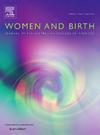塑造可持续未来:育龄妇女的气候相关压力和暴力:系统综述
IF 4.1
2区 医学
Q1 NURSING
引用次数: 0
摘要
气候变化是一场不断升级的全球危机,对妇女的影响尤为严重,尤其是在遭受性别暴力方面。然而,与气候相关的压力因素与育龄妇女的性别暴力之间的交叉关系仍未得到充分探讨。干旱、热浪和洪水等环境破坏日益与针对妇女的暴力行为联系在一起。这些压力源通常会加剧经济困难、流离失所和已知会增加性别暴力风险的社会心理压力因素。目的系统地研究15-49岁妇女中与气候相关的压力源与性别暴力经历之间的关系,包括亲密伴侣暴力(IPV)、性暴力和童婚。方法按照PRISMA 2020进行系统评价。在六个数据库中检索了同行评议的研究(2010-2024),这些研究报告了气候压力源和GBV的经验数据。符合条件的研究包括以育龄妇女为重点的定量或混合方法研究。使用ROBVIS工具提取数据并评估偏倚风险。17项研究符合纳入标准。大多数来自低收入和中等收入国家。干旱和极端高温一直与IPV、童婚和性暴力的增加有关。中介因素包括流离失所、粮食不安全和心理健康挑战。气候相关压力因素通过多种途径放大性别暴力风险。流离失所、经济紧张和社会保护机制中断加剧了妇女在环境危机中的脆弱性。气候适应工作必须纳入促进性别平等的战略,以预防和应对性别暴力。解决这一交叉问题对于在变暖的世界中保障妇女的健康、权利和复原力至关重要。本文章由计算机程序翻译,如有差异,请以英文原文为准。
Shaping a sustainable future: Climate-related stress and violence among women of reproductive age: A systematic review
Problem
Climate change is an escalating global crisis with disproportionate effects on women, particularly regarding exposure to gender-based violence (GBV). Yet, the intersection between climate-related stressors and GBV among women of reproductive age remains underexplored.
Background
Environmental disruptions such as droughts, heatwaves, and floods are increasingly linked to violence against women. These stressors often intensify economic hardship, displacement, and psychosocial stress—factors known to elevate GBV risk.
Aim
To systematically examine the association between climate-related stressors and experiences of GBV, including intimate partner violence (IPV), sexual violence, and child marriage among women aged 15–49 years.
Methods
A systematic review was reported in accordance with PRISMA 2020. Six databases were searched for peer-reviewed studies (2010–2024) reporting empirical data on climate stressors and GBV. Eligible studies included quantitative or mixed-methods research focused on women of reproductive age. Data were extracted and assessed for risk of bias using the ROBVIS tool.
Findings
Seventeen studies met inclusion criteria. Most were from low- and middle-income countries. Droughts and extreme heat were consistently associated with increased IPV, child marriage, and sexual violence. Mediating factors included displacement, food insecurity, and mental health challenges.
Discussion
Climate-related stressors amplify GBV risks via multiple pathways. Displacement, economic strain, and disrupted social protection mechanisms heighten women's vulnerability during environmental crises.
Conclusion
Climate adaptation efforts must incorporate gender-responsive strategies to prevent and respond to GBV. Addressing this intersection is essential to safeguard women’s health, rights, and resilience in a warming world.
求助全文
通过发布文献求助,成功后即可免费获取论文全文。
去求助
来源期刊

Women and Birth
NURSING-OBSTETRICS & GYNECOLOGY
CiteScore
7.20
自引率
13.20%
发文量
371
审稿时长
27 days
期刊介绍:
Women and Birth is the official journal of the Australian College of Midwives (ACM). It is a midwifery journal that publishes on all matters that affect women and birth, from pre-conceptual counselling, through pregnancy, birth, and the first six weeks postnatal. All papers accepted will draw from and contribute to the relevant contemporary research, policy and/or theoretical literature. We seek research papers, quality assurances papers (with ethical approval) discussion papers, clinical practice papers, case studies and original literature reviews.
Our women-centred focus is inclusive of the family, fetus and newborn, both well and sick, and covers both healthy and complex pregnancies and births. The journal seeks papers that take a woman-centred focus on maternity services, epidemiology, primary health care, reproductive psycho/physiology, midwifery practice, theory, research, education, management and leadership. We also seek relevant papers on maternal mental health and neonatal well-being, natural and complementary therapies, local, national and international policy, management, politics, economics and societal and cultural issues as they affect childbearing women and their families. Topics may include, where appropriate, neonatal care, child and family health, women’s health, related to pregnancy, birth and the postpartum, including lactation. Interprofessional papers relevant to midwifery are welcome. Articles are double blind peer-reviewed, primarily by experts in the field of the submitted work.
 求助内容:
求助内容: 应助结果提醒方式:
应助结果提醒方式:


